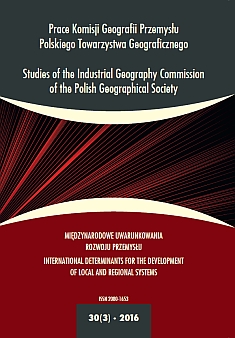The Chief Determinants of Crude Oil Prices in the World in 2014 and 2015
DOI:
https://doi.org/10.24917/20801653.303.14Keywords:
oil, oil price fluctuations, oil shocks, OPEC, shale revolution, price warAbstract
Similarly as in the case of many other commodities, the prices of crude oil fluctuate. The main determinantsof crude oil prices comprise:--market-related factors, which are the long-term drivers of crude oil price tendencies: supply and demand,--short-term drivers, such as investors’ sentiments and geopolitical events, OPEC decisions, USD exchangerates, economic prognoses.It is difficult to attribute the dramatic drop of crude oil prices, which started in 2014, solely to the market-relatedcauses. This drastic decrease of crude oil prices ended a four-year long period of relative stability ofthe price oscillating around 105 US dollars per barrel. The drop in prices, which is significantly larger than inthe case of other raw products, and in comparison with the “peak prices” from 2011, might indicate the end of the “super cycle” of crude oil prices. The purpose of this article is a comprehensive analysis of the factorsdetermining the crude oil prices in the period of 2014-2015, as well as to answer the following questions:--what is the main driving force of the decrease in prices of the most important energy carrier on the internationalmarket of raw materials?--what actions on the world market lead to the decrease of crude oil prices?--what are the consequences of the decrease of crude oil prices on the world market for both the suppliersand the recipients?Downloads
Metrics
References
BP Statistical Review of World Energy (2015). Pozyskano z http://www.bp.com/en/global/corporate/ energy-economics/statistical-review-of-world-energy.html
Davis, J. (2006). The Changing World of Oil: An Analysis of Corporate Change and Adaptation. Farnham: Ashgate.
Global Economic Prospects (2015). Understanding the Plunge in Oil Prices: Sources and Implications.Having Fiscal Space and Using It. Washington: International Bank for Reconstruction and Development / The World Bank.
IEA (2015). Medium Term Oil Market Report. Pozyskano z https://www.iea.org/publications/ freepublications/publication/MTOMR_2015_Final.pdf
Kosowski, P., Rychlicki, S., Stopa J. (2008). Transakcje na rynku „spot” i „futures” na rynku ropy naftowej. Wiertnictwo Nafta Gaz, 25(2).
Kowalski, W. (2009). Wszystko o rynku ropy naftowej. Poznań: EFIX Dom Maklerski.
Maugeri, L.(2006). The Age of Oil: The Mythology, History, and Future of the World’s Most Controversial Resource. Westport, Connecticut, London: PRAEGER.
Nafta Polska (2015, 12 grudnia). Pozyskano z http://www.nafta-polska.pl/
Pach-Gurgul, A. (2013). Perspektywy wykorzystania gazu łupkowego w energetyce Unii Europejskiej. Prace Komisji Geografii Przemysłu Polskiego Towarzystwa Geograficznego, 21, 63–77.
Ross, L.M. (2012). The Oil Curse: How Petroleum Wealth Shapes the Development of Nations. Oxford: Princeton University Press.
Socha, R. (2013). Analiza relacji wybranych cen gatunków ropy naftowej. Polityka Energetyczna, 16(2).
Torchała, A. (2015). Ropa naftowa najtańsza od sześciu lat. Pozyskano z http://www.bankier.pl/ wiadomosc/Ropa-naftowa-najtansza-od-szesciu-lat-7289519.html
World Oil Outlook (2014). Vienna: Organization of the Petroleum Exporting Countries.
Downloads
Published
How to Cite
Issue
Section
License
Articles are published under the terms of the Creative Commons License (CC BY-ND 4.0; Attribution– NoDerivs).

